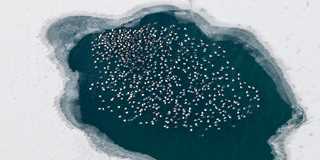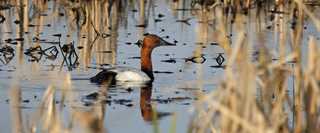Understanding Waterfowl: Canvasbacks in Winter
The distribution of these highly prized birds is closely tied to water quality and food availability
The distribution of these highly prized birds is closely tied to water quality and food availability
By Michael G. Anderson, Ph.D.
Delta Marsh, Lake Christina, Long Point, Susquehanna Flats, Pamlico Sound, Keokuk, Catahoula Lakethese evocative names are known to many waterfowlers because of their historical importance to the King of Ducks. But much has changed since Chesapeake Bay market gunners supplied prime canvasbacks to the Baltimore market for five dollars a pair. For decades, the location, timing, and duration of wintering habitat use by canvasbacks has been changing. Shifts in the birds distribution have largely been driven by declining water quality and food availability on traditional wintering areas.
Canvasbacks follow three main migration routes from their breeding marshes to winter quarters. In the Pacific Flyway, Alaskan birds depart first, followed by Yukon and Alberta breeders. These birds begin arriving along the California coast as early as late October. The majority winter in the Golden State, primarily in the Central Valley and on San Francisco Bay. Smaller numbers winter in southwestern British Columbia, Washingtons Puget Sound, and on scattered ice-free lakes throughout the Intermountain West.
From the central prairies, where most canvasbacks nest, the birds initial movement is southeast. Many of these birds stage on the upper pools of the Mississippi River, which can host up to 50 percent of the continents canvasbacks at peak times. In November, some move east and south, across Wisconsin, Michigan, and the eastern Great Lakes to the Atlantic coast. The rest head to wintering areas in the Lower Mississippi River Valley, the Gulf Coast, Texas, and northern Mexico. The majority of Mississippi Flyway canvasbacks winter in Louisiana, with up to two-thirds of those birds gathering on Catahoula Lake. Others can be found along the Gulf Coast, especially in the Mississippi River Delta. In the Atlantic Flyway, canvasbacks winter from New York to Florida, with the largest numbers gathering on Chesapeake Bay and in coastal North Carolina.

Photo DAVIDSTIMAC.COM
How far and how fast canvasbacks migrate depends on the weather. Many canvasbacks remain up north until ice covers their food supplies and they are forced to continue their journey south. Surprisingly, male and female canvasbacks tend to settle in different places for the winter. Analyses of waterfowl surveys, aerial photographs, and Christmas Bird Counts show that canvasback flocks contain a higher ratio of males to females in northern portions of the species wintering range. During the 1980s, researchers found that nearly 80 percent of the canvasbacks on Chesapeake Bay were males, while on North Carolinas Pamlico Sound, only 61 percent were males. At the same time, 56 percent of the canvasbacks identified in Louisiana were males. On the mid-Atlantic coast, the percentage of males decreased between December and March, initially as more females arrived from the north and later as females moved up from the south.
Why this pattern exists is unclear. Males are a bit larger than females and may be able to better withstand cold and the occasional fasting caused by inclement weather. Some believe that because males tend to dominate females in conflicts over feeding or roosting habitats, females may drift farther south to avoid competition. Others think that adult males simply arrive earlier and occupy northern wintering areas first. Whatever the cause, similar patterns of distribution in males and females have been observed among wintering ring-necked ducks in North America and common pochards in Europe and Africa.
In contrast to larger species of dabbling ducks, which typically find mates on the wintering grounds, most canvasbacks pair during spring migration. Thus, life for canvasbacks in winter is mainly about acquiring and conserving energy as well as avoiding hunters and escaping predators such as bald eagles. For these strictly aquatic birds, wetland foods are key. Canvasbacks are well adapted for excavating energy-rich underground plant parts like tubers and rootstocks. They have large feet for their body size; a long, muscular neck; and a strong wedge-shaped bill for probing and extracting food. The close association between canvasbacks and submersed aquatic vegetation is well known. When Alexander Wilson first described the species scientifically more than 200 years ago, he chose the name valisineria, derived from the genus name of one of the canvasbacks favorite foodswild celery. 
Photo Michael Furtman
While they prefer plant foods, at times canvasbacks will add clams, snails, insect larvae, and even fish to their diet. On Chesapeake Bay, the diet of canvasbacks consisted predominantly of wild celery until declining water quality during the latter half of the 20th century dramatically reduced the abundance of this vegetation. Canvasbacks responded by moving to other wintering areas to the south or by switching to a diet of small clams.
Estuaries and many big lakes lie at the end of the pipe in watershed terms. The health of these water bodies reflects how we use the land and manage our water resources. For canvasbacks, which rely exclusively on aquatic food sources, water quality on traditional migration and wintering areas is paramount. Sadly, many traditional canvasback wintering areas have fared poorly as we have developed our coastlines and watersheds. Runoff carrying excess nutrients and soil and a host of pollutants has sullied many habitats for fish, wildlife, and people.
Chesapeake Bay is a prime example of these challenges. The estuary has an enormous watershed, spanning some 65,000 square miles. The number of people living in this region has increased dramatically since 1950, resulting in extensive wetland losses and degraded water quality in the bay. By the 1970s, thousands of acres of submersed aquatic plants had been lost. But the latest news from scientists is heartening. Recent improvements in water quality, especially the reduction of nitrogen and phosphorous entering the bay, have allowed more than 42,000 acres of submersed aquatic plants to return. The extensive conservation of wetlands and associated uplands in the Chesapeake Bay watershed, much of it on agricultural lands far from the estuary, has contributed to this turnaround.
Some progress has also been made in the Mississippi River Delta, where crevasses created in levees have allowed accretion of soil and plants like bulrush and arrowhead to become reestablished. In the Pacific Flyway, the restoration of former industrial salt ponds to tidal wetlands on San Francisco Bay is providing valuable habitat for fish and wildlife and improving the health of the estuary. Challenges remain, however, as pollution, development, and rising sea levels continue to pose serious threats to key migration and wintering areas for canvasbacks and other waterfowl. Moreover, the birds most important breeding habitats in the Prairie Pothole Region remain vulnerable to conversion and continue to be lost at alarming rates.
In the future, canvasbacks will thrive if we look after their needs. Thankfully, North American Waterfowl Management Plan joint ventures on the Atlantic Coast, Great Lakes, Upper Mississippi River, Gulf Coast, San Francisco Bay, and other areas are working to improve these habitats, and Ducks Unlimited is a key partner in all these efforts. By supporting DUs work, you are playing an important role in providing crucial habitat for canvasbacks and other waterfowl. But change is constant in wetland environments, and we must remain vigilant to ensure that the King of Ducks continues to grace our skies.
Dr. Mike Anderson is emeritus scientist with Ducks Unlimited Canada and a freelance writer based in Winnipeg, Manitoba.
Ducks Unlimited uses cookies to enhance your browsing experience, optimize site functionality, analyze traffic, and deliver personalized advertising through third parties. By continuing to use this site, you agree to our use of cookies. View Privacy Policy